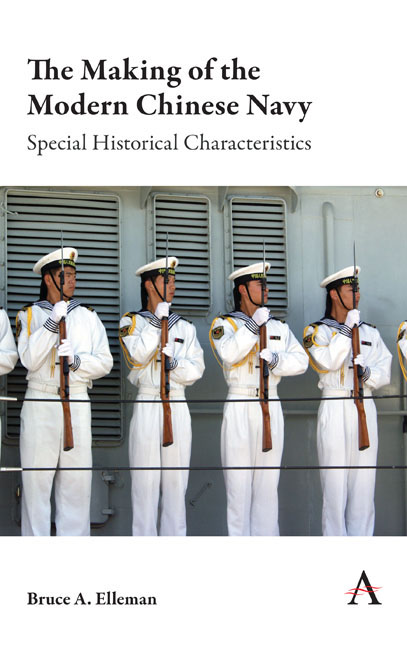Book contents
- Frontmatter
- Contents
- Introduction: The Special Characteristics of China's Maritime History
- 1 Battle of Bạch Đăng River (938)
- 2 Battle of Yaishan (1279)
- 3 Battle of Lake Poyang (1363)
- 4 Ming–Kotte War in Southeast Asia (1410–11)
- 5 Ming Loyalists Flee to Taiwan (1661–83)
- 6 Battle of Chuanbi (1839)
- 7 Sino-French War (1884–85)
- 8 Qing Beiyang Fleet's Defeat in the Battle of the Yellow Sea (1894)
- 9 Chinese Decision to Sink The Nationalist Navy as Blockships (1937)
- 10 Chongqing Mutiny Allowing the PLA to Cross the Yangzi River (1949)
- 11 The Taiwan Strait Crises (1954–55 and 1958)
- 12 China's Decision to Take the Paracel Islands from South Vietnam (1974)
- 13 Missile Blockade: The Taiwan Strait Crisis (1995–96)
- 14 The EP-3 Standoff and Diplomatic Resolution (2001)
- Conclusions: The Influence of History on the Formation of a Modern Chinese Navy
- Selected Bibliography
- Index
8 - Qing Beiyang Fleet's Defeat in the Battle of the Yellow Sea (1894)
Published online by Cambridge University Press: 04 October 2019
- Frontmatter
- Contents
- Introduction: The Special Characteristics of China's Maritime History
- 1 Battle of Bạch Đăng River (938)
- 2 Battle of Yaishan (1279)
- 3 Battle of Lake Poyang (1363)
- 4 Ming–Kotte War in Southeast Asia (1410–11)
- 5 Ming Loyalists Flee to Taiwan (1661–83)
- 6 Battle of Chuanbi (1839)
- 7 Sino-French War (1884–85)
- 8 Qing Beiyang Fleet's Defeat in the Battle of the Yellow Sea (1894)
- 9 Chinese Decision to Sink The Nationalist Navy as Blockships (1937)
- 10 Chongqing Mutiny Allowing the PLA to Cross the Yangzi River (1949)
- 11 The Taiwan Strait Crises (1954–55 and 1958)
- 12 China's Decision to Take the Paracel Islands from South Vietnam (1974)
- 13 Missile Blockade: The Taiwan Strait Crisis (1995–96)
- 14 The EP-3 Standoff and Diplomatic Resolution (2001)
- Conclusions: The Influence of History on the Formation of a Modern Chinese Navy
- Selected Bibliography
- Index
Summary
The proper adaption and efficient use of Western naval equipment has been a constant challenge to China. In the opening days of the first Sino-Japanese War, foreigners were convinced that China would win. Two of its German-made ships had such thick armor that the Japanese guns could not pierce them. During September 1894, however, the Japanese defeated China in the Battle of the Yellow Sea (also called the Battle of the Yalu). Not only did the Chinese ships have inadequate ammunition, and so quickly ran out, but putting the heavier ships in the center to protect them allowed the Japanese to pick off the older and weaker ships on the wings, thus easily winning the battle.
Summary of the 1894–95 Sino-Japanese War
The Chinese navy has arguably only engaged in one full-scale “modern” naval battle against a foreign opponent. By the early 1890s, China's navy was ranked eighth in the world, with a total of 65 ships, compared to Japan's eleventh ranking with only 32 ships. Immediately prior to the beginning of the Sino-Japanese War, one British admiral even claimed that China's Navy “would prove more than a match for the Japanese at sea; in fact, the Japanese would not be in it.” Within each separate fleet, however, there was a notable lack of central authority. As described by William Tyler, the Beiyang fleet was like a “machine” whose “complexity lay in a vast muddle of diverse motives and ideals.” Instead of order, from the Viceroy down to the director of the arsenal, the interlocking “wheels revolved to no general purpose but only to their own.” In the midst of this confusion, there could be no “homogeneity of purpose,” but only a “monstrously disordered epicyclic heterogeneity.” The lack of a unified naval structure, both to connect the various fleets and to direct them efficiently as individual units, proved to be an enormous disadvantage for the Chinese navy.
The September 17, 1894 Battle of the Yellow Sea set the course of the Sino-Japanese War. Admiral Ding Ruchang and the other high-ranking Chinese officers came from the Army and so were woefully untrained in modern naval strategy and tactics. On the day of the battle, Admiral Ding's ten ships were sailing in what has widely been described as a wedge-shaped formation.
- Type
- Chapter
- Information
- The Making of the Modern Chinese NavySpecial Historical Characteristics, pp. 39 - 42Publisher: Anthem PressPrint publication year: 2019



